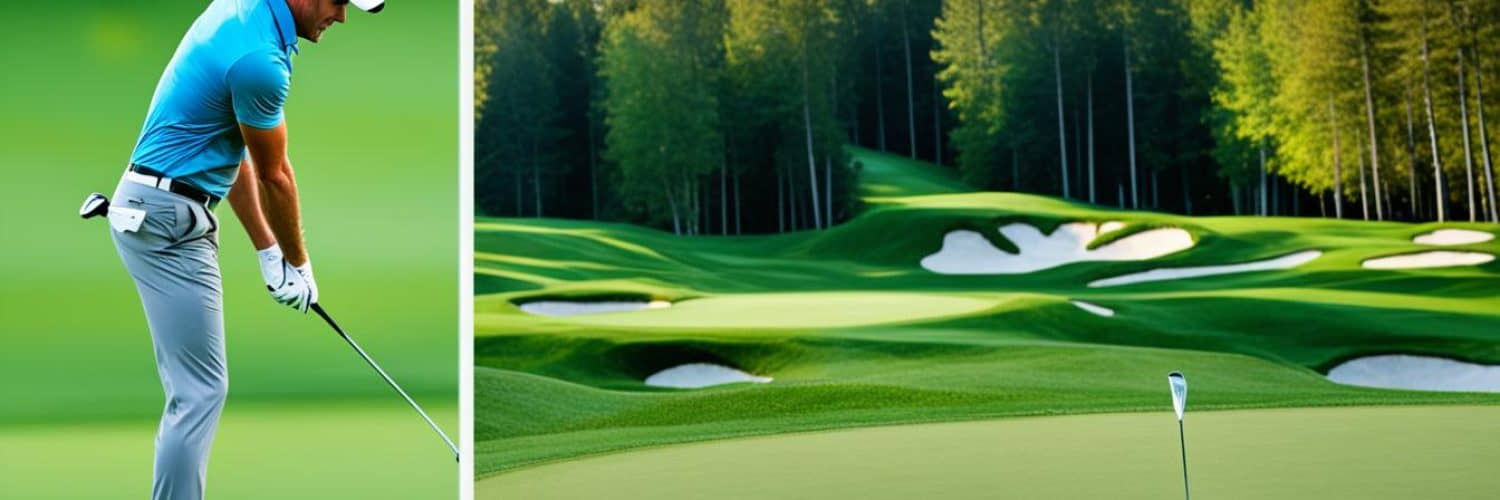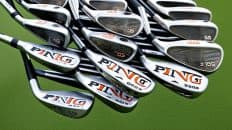Golf clubs average distance is a topic of great importance for golfers of all skill levels. Understanding how far each club can hit can greatly improve your game and help you make better decisions on the course. In this guide, we will explore the average distances of different golf clubs, discuss factors that can impact distance, and provide tips for improving your golf club distance.
Key Takeaways:
- Knowing the average distances of different golf clubs is essential for making informed decisions on the course.
- Factors such as club loft, shaft weight and flex, swing speed, clubhead design, and weather conditions can impact golf club distance.
- On average, male golfers hit the ball farther than female golfers, but individual results may vary.
- Setting realistic goals based on your skill level and tracking your progress are crucial for improving golf club distances.
- Investing in high-quality equipment and getting custom club fitting can maximize your golf club distances.
Average Golf Club Distance: What to Expect on the Green
The average distances of golf clubs can vary based on various factors such as swing speed, skill level, and physical abilities. While there is no one-size-fits-all answer, we can provide a general guideline for the average distances of different clubs.
Based on data from golf professionals and industry experts, here is a breakdown of the average distances for male golfers based on swing speed:
| Club | Average Distance (yards) |
|---|---|
| Driver | 240-320 |
| 3 Wood | 215-275 |
| 5 Wood | 195-235 |
| 3 Iron | 180-220 |
| 4 Iron | 170-210 |
| 5 Iron | 160-200 |
| 6 Iron | 150-190 |
| 7 Iron | 140-180 |
| 8 Iron | 130-170 |
| 9 Iron | 120-160 |
| Pitching Wedge | 110-150 |
| Gap Wedge | 90-120 |
| Sand Wedge | 80-100 |
| Lob Wedge | 60-80 |
Please note that these distances are averages and individual results may vary. Other factors such as swing mechanics, course conditions, and environmental factors can also influence the distances achieved with each club.
Remember, these average distances provide a guideline, but it’s essential to assess your own abilities and playstyle to determine your optimal distances. Practice, experience, and technique play a significant role in achieving desired results on the golf course.
PGA Tour Players’ Average Distances
For a glimpse into the distances achieved by professional golfers, here are the average distances of PGA Tour players:
- Driver: 280-320 yards
- 3 Wood: 240-280 yards
- 5 Wood: 220-250 yards
- 2 Iron: 240-260 yards
- 3 Iron: 225-245 yards
- 4 Iron: 210-230 yards
- 5 Iron: 200-220 yards
- 6 Iron: 190-205 yards
- 7 Iron: 180-190 yards
- 8 Iron: 165-180 yards
- 9 Iron: 150-165 yards
- Pitching Wedge: 135-150 yards
- Sand Wedge: 115-135 yards
- Lob Wedge: 70-100 yards
Keep in mind that these numbers represent the average distances of professional golfers and may not directly align with your own game. It is always best to focus on improving your personal performance and finding the distances that work best for your game.
Factors Affecting Golf Club Distance
When it comes to golf club distance, several factors come into play. Understanding these factors can help golfers optimize their performance on the course and achieve their desired distances. Let’s take a closer look at the key factors affecting golf club distance:
1. Loft Angle
Loft angle refers to the angle of the clubface in relation to the ground. Lower loft angles, such as those found in drivers, typically result in longer distances. This is because lower loft angles produce a lower ball trajectory, allowing the ball to travel further through the air.
2. Shaft Weight and Flex
The weight and flex of the shaft can greatly impact golf club distance. A lighter shaft can help increase swing speed, which in turn leads to greater distance. Additionally, the flex of the shaft affects the transfer of energy from the golfer’s swing to the clubhead, influencing the distance achieved.
3. Swing Speed
Swing speed plays a crucial role in golf club distance. The faster the swing speed, the more power is generated, resulting in greater distances. Golfers with higher swing speeds can typically achieve longer shots with each club.
4. Clubhead
The size and design of the clubhead can impact distance. Larger clubheads provide a larger sweet spot, increasing the chance of solid contact with the ball. Additionally, certain clubhead designs, such as those with adjustable weights, can help optimize distance and ball flight.
5. Age and Health
A golfer’s age and health can also influence golf club distance. Younger, healthier golfers tend to have more strength and flexibility, allowing them to generate greater power in their swings. However, golfers of all ages and health conditions can improve their distances through proper technique and conditioning.
6. Weather Conditions
Weather conditions, such as wind and temperature, can affect golf club distance. Headwinds can cause the ball to carry shorter distances, while tailwinds can increase distance. Additionally, colder temperatures can lead to decreased ball compression and shorter shots.
7. Golf Balls
The type of golf ball being used can also impact distance. Different golf balls have varying levels of spin and compression, which can affect the ball’s flight and distance. Choosing the right golf ball for your game can help optimize your distances.
Understanding and considering these factors can give golfers valuable insights into how to achieve greater distances with their golf clubs. By adjusting aspects such as loft angle, shaft weight and flex, swing speed, clubhead design, and by taking into account personal factors such as age, health, weather conditions, and golf ball selection, golfers can optimize their performance and maximize their distances on the course.
| Factor | Impact on Distance |
|---|---|
| Loft Angle | Lower loft angles result in longer distances. |
| Shaft Weight and Flex | Lighter shafts and appropriate flex can increase distance. |
| Swing Speed | Higher swing speed generates more power and distance. |
| Clubhead | Size and design impact distance and ball flight. |
| Age and Health | Youth and fitness can contribute to greater distances. |
| Weather Conditions | Wind and temperature can affect how far the ball carries. |
| Golf Balls | Ball type influences spin, compression, and distance. |
Average Golf Club Distances for Men and Women
The average golf club distances can vary between men and women. On average, male golfers tend to hit the ball farther with each club compared to female golfers. Here is a breakdown of the average distances for each club:
| Golf Club | Men’s Average Distance (yards) | Women’s Average Distance (yards) |
|---|---|---|
| Driver | 240-280 | 200-230 |
| 3-Wood | 215-235 | 180-210 |
| 5-Wood | 195-215 | 160-190 |
| 3-Iron | 190-210 | 150-180 |
| 4-Iron | 180-200 | 140-170 |
| 5-Iron | 170-190 | 130-160 |
| 6-Iron | 160-180 | 120-150 |
| 7-Iron | 150-170 | 110-140 |
| 8-Iron | 140-160 | 100-130 |
| 9-Iron | 130-150 | 90-120 |
| Pitching Wedge | 120-140 | 80-110 |
| Gap Wedge | 110-130 | 70-100 |
| Sand Wedge | 90-110 | 60-90 |
| Lob Wedge | 70-90 | 50-80 |
Remember, these are just average distances, and individual results may vary. Factors such as swing technique, physical strength, and club fitting can also affect the distance achieved with each club. It’s important to focus on consistency and accuracy rather than solely chasing distance.
“Distance is just one aspect of the game. Precision and control are equally important, which is why every golfer should aim to find the right balance between power and accuracy.”
While it’s interesting to compare average distances, it’s essential to understand that there’s more to golf than distance alone. While male golfers generally hit the ball farther, women’s golfers often make up for it with accuracy and finesse. Remember, golf is a game of strategy and skill, and mastering all aspects of the game will ultimately lead to better scores.
Setting Goals for Golf Club Distances
When it comes to optimizing your golf club distances, setting clear goals is key. By understanding the average distances of different clubs and aiming to improve upon them, you can make better decisions on the course and enhance your overall game.
Setting goals for golf club distances should be based on your individual skill level and physical abilities. It’s important to be realistic and consider factors such as swing speed, loft angle, and clubhead design. By assessing your current distances and identifying areas for improvement, you can set achievable targets that will help you progress.
Optimizing club distances goes beyond simply hitting the ball farther. It also involves achieving consistency and accuracy with each club in your bag. Good golf club distances are not only about distance but also about control over the ball’s trajectory and hitting accurate shots.
One approach to setting goals for golf club distances is to aim for distances that are close to or above the average ranges for each club. This can provide a benchmark to work towards and help you gauge your progress. However, it’s important to keep in mind that the average distances are just that – averages. Individual results may vary based on various factors.
Additionally, focusing on optimizing distances should be complemented by working on your technique, physical fitness, and overall golf game. As you improve your swing mechanics, increase your strength and flexibility, and enhance your overall skills, your club distances are likely to improve as well.
Remember, setting goals for golf club distances is a personal journey. It’s important to celebrate small achievements along the way and enjoy the process of improvement. By setting realistic goals and dedicating consistent practice and effort, you can enhance your golf club distances and elevate your overall performance on the course.
Tips for Setting Goals for Golf Club Distances:
- Assess your current distances with each club
- Consider your skill level and physical capabilities
- Focus on achieving consistent and accurate shots
- Aim for distances close to or above the average ranges
- Work on improving technique, physical fitness, and overall game
- Celebrate small achievements along the way
By setting realistic goals and striving for improvement, you can optimize your golf club distances and take your game to new heights.
Improving Golf Club Distances: Tips and Strategies
Improving your golf club distances is a goal shared by many golfers looking to enhance their game. By following these tips and strategies, you can increase the distance of your shots and achieve longer drives on the course.
1. Focus on improving swing mechanics
An efficient and powerful swing is essential for maximizing your golf club distances. Work on your swing mechanics by practicing with proper form and technique. Remember to maintain a smooth tempo, generate clubhead speed, and make solid contact with the ball.
2. Work on physical fitness and strength
A strong and flexible body can greatly contribute to increased golf club distances. Incorporate exercises that target core strength, rotational power, and flexibility into your fitness routine. This can help you generate more power and optimize your swing mechanics.
3. Get custom club fitting
A custom club fitting can make a significant difference in your golf club distances. By having your clubs fitted to your specific swing characteristics and physical attributes, you can ensure optimal performance and maximize distance potential.
4. Keep track of your distances
Tracking your distances for each club is crucial for improvement. Use a golf GPS device or range finder to measure the distance of your shots during practice sessions and rounds. This data will help you identify strengths and weaknesses and make necessary adjustments to optimize your distances.
5. Regular practice sessions and seek professional coaching
Consistent practice is key to improving your golf club distances. Set aside regular practice sessions to work on your swing, technique, and strength training. Additionally, consider seeking professional coaching to receive guidance and feedback on your game, helping you make targeted improvements.
6. Utilize golf tech devices
Golf tech devices such as launch monitors and swing analyzers can provide valuable insights into your swing and help you identify areas for improvement. These tools can measure swing speed, launch angle, and other metrics, allowing you to make data-driven adjustments to optimize your distances.
Remember, improving your golf club distances takes time and consistency. Incorporate these tips and strategies into your golf practice routine and be patient with the process. By focusing on technique, physical fitness, and utilizing technology, you can gradually increase your distances and take your game to the next level.
In Summary
To improve your golf club distances:
- Focus on improving swing mechanics
- Work on physical fitness and strength
- Get custom club fitting
- Keep track of your distances
- Regular practice sessions and seek professional coaching
- Utilize golf tech devices
Tracking Your Golf Club Distances
A crucial aspect of improving your golf club distances is tracking your shots and recording the distances for each club. This allows you to assess your strengths and weaknesses, identify areas for improvement, and make more informed decisions on the course.
To effectively track your golf club distances, it is recommended to engage in regular practice sessions on the course or at the driving range. During these practice sessions, focus on hitting shots with each club in your bag to assess the distance they cover. Take note of the distances achieved with each club and record them for future reference.
One convenient and accurate way to track your distances is by using golf GPS devices. These devices provide real-time information on the distance of your shots, allowing you to easily keep track of your progress. Additionally, many golf GPS devices offer features such as shot tracking and club recommendations based on your previous shots, helping you refine your distance control.
Another useful tool for tracking golf club distances is the use of sensors on your clubs. These sensors can provide detailed data on factors such as clubhead speed, swing path, and ball flight. By analyzing this data, you can gain insights into your swing mechanics and make adjustments to improve your distance and accuracy.
Tracking your golf club distances not only helps you understand your game better but also serves as a valuable reference for future rounds. It enables you to make more strategic decisions on club selection, target distances, and shot execution.
| Club | Recorded Distance |
|---|---|
| Driver | 280 yards |
| 3-Wood | 250 yards |
| 5-Iron | 200 yards |
| 7-Iron | 175 yards |
| 9-Iron | 150 yards |
| Pitching Wedge | 125 yards |
| Sand Wedge | 100 yards |
By consistently tracking your golf club distances, you can gain valuable insights into your game and work on improving your performance. Remember, practice makes perfect, and with accurate distance tracking, you can optimize your club selection, shot execution, and overall game strategy.
The Role of Equipment in Golf Club Distances
When it comes to optimizing your golf club distances, the quality of equipment plays a vital role. By using high-quality clubs and balls, you can enhance your distances and improve your accuracy on the course. Additionally, custom club fitting is crucial for maximizing your efficiency and achieving optimal distance.
Investing in high-quality clubs and balls can make a noticeable difference in your golf club distances. These premium options are designed with advanced technologies and features that can help you generate more power and achieve greater distances. They offer improved forgiveness, control, and consistency, allowing you to hit the ball with precision.
Custom club fitting is another key factor in maximizing your golf club distances. Every golfer has unique physical attributes and swing characteristics that influence their performance. By getting custom fitted, you can ensure that your clubs are tailored specifically to your needs. The right shaft flex, weight, and length, combined with the optimal loft angle, can significantly impact your distance and overall game.
During a custom club fitting session, a trained professional will analyze your swing and gather data to determine the perfect club specifications for you. This personalized approach takes into account your swing speed, tempo, launch angle, and ball flight, among other factors. The result is a set of clubs that are perfectly suited to your individual style and help maximize your potential on the course.
Optimizing your golf club distances through high-quality equipment and custom fitting is an investment in your game. Not only will you see improvements in distance, but also in accuracy, consistency, and overall performance. Take the time to research and choose the right clubs and balls for your game, and don’t underestimate the benefits of custom club fitting.
Conclusion
Summing up, understanding golf club distances is vital for enhancing your game on the course. By familiarizing yourself with the average distances of different clubs, recognizing the factors that affect distance, and implementing tips for improvement, you can optimize your club distances and make better decisions during your rounds. Remember, improvement in golf club distance is a gradual process that requires dedication and consistency.
Setting realistic goals based on your skill level and physical abilities is essential. Focus on improving your swing mechanics, investing time in physical fitness and strength training, and seeking professional coaching when needed. Tracking your golf club distances is another valuable practice that allows you to identify areas for improvement and tailor your game accordingly.
Lastly, the role of equipment should not be underestimated. Invest in high-quality clubs and golf balls to maximize your distances and accuracy. Custom club fitting, done by professionals who consider your unique physical attributes and swing characteristics, can further enhance your club distances. By implementing these strategies and staying committed, you can work towards achieving your desired golf club distances and elevate your performance on the course. Enjoy the game and keep striving for improvement!
FAQ
What is the average distance of golf clubs?
The average distances of golf clubs can vary based on factors such as swing speed, skill level, and physical abilities. While there is no one-size-fits-all answer, we can provide a general guideline for the average distances of different clubs.
What factors can impact golf club distance?
Several factors can impact golf club distance, including the loft angle of the club, weight and flex of the shaft, golfer’s swing speed, size and design of the clubhead, age and health, weather conditions, and the type of golf ball being used.
How do average golf club distances differ for men and women?
Male golfers, on average, hit the ball longer distances with each club compared to female golfers. However, it is important to note that these are just averages and individual results may vary.
How can I improve my golf club distances?
Improving golf club distances can be achieved through various tips and strategies, including focusing on swing mechanics, physical fitness and strength, custom club fitting, and regular practice sessions. Seeking professional coaching and using golf tech devices can also contribute to increasing distances.
How can I track my golf club distances?
Tracking your golf club distances can be done through regular practice sessions, using golf GPS devices, and recording the distances for each club. These measurements can help identify areas for improvement and make more informed decisions on the course.
Does equipment impact golf club distances?
Yes, the quality of equipment can significantly impact golf club distances. Using high-quality clubs and balls can contribute to better distances and accuracy. Custom club fitting, based on individual physical attributes and swing characteristics, can also maximize efficiency and distance.
What are the key takeaways for golf club distances?
Understanding average distances, factors affecting distance, and tips for improvement can help golfers optimize their club distances and improve their overall game. By setting goals, focusing on technique and physical fitness, and tracking progress, golfers can work towards achieving their desired distances and enhancing their performance on the course.







Add comment